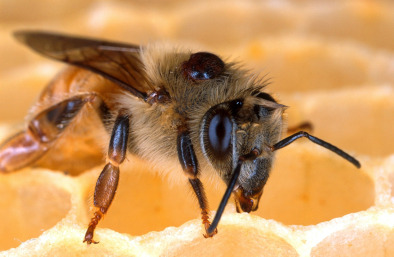Varroa
Varroasis
Varroasis is the only disease that attacks adult bees and bee colonies, while all other diseases and pests attack only adult bees or only bee colonies. The disease is caused by the pest-parasite in the form of Varroa jacobsoni which also attacks the bee brood and adult bees, making it very dangerous when it appears on a larger scale.
The danger is greatest in the initial stage of disease development when bee colonies develop and live almost normally. Beekeepers may not notice the disease at this stage. However, when it spreads, it can cause significant devastation in the apiary. In some cases, varroa can completely destroy a large number of bee colonies, or even all of them. Beekeepers can recognize the presence of varroa when they notice a lot of honey in the hive and brood, but very few bees or none at all on one, two, or at most three frames. The rest of the bees in the hive are often so damaged by varroa that, when the necessary measures are taken to treat them, there are usually no results. In such cases, huge damages occur.

The disease was first discovered in 1904 on the island of Java by a wild bee and was identified by the Dutchman Jakobson. It was not until 1950 that it was first observed on a honey bee.
It was first discovered in Japan in 1958 on a honey bee and in 1958 it was found in China. It was first discovered in Russia in 1962 and in Romania in 1972.
This disease is so widespread that it is present all over the world, and it was first diagnosed in our country in 1976.
The parasite is visible to the naked eye and is dark brown in color. At first glance, it looks like a bee, but it is smaller than a bee and has four pairs of legs, while bees have three pairs of legs. Female parasites live for two to three months in spring and summer and six to eight months in autumn and winter.
Spread of Disease
Varroa can spread very quickly, infecting beehives up to 60 km away by air in just one year.
The rapid spread of varroa can be attributed to various factors. Drones, which move up to 16 km away from the apiary and enter other hives, are considered to be great carriers of the disease.
Other contributing factors include predation, transfer of frames with honeycombs and bees from one hive to another, migration of bees from infected to uninfected areas and vice versa, and contact between worker bees when landing on flowers of honey plants.
Additionally, it is believed that other insects such as bumblebees, wasps, hornets, and others may transmit varroa between hives within the same apiary and from one apiary to another.
Reproduction of Varroa
The reproduction of varroa parasites begins in early spring, with the appearance of brood in the bee colony. Female varroa lay eggs in honeycomb cells that already have hatched larvae, typically when the brood is 5-6 days old, just before the brood closes.
A female varroa usually lays one to three eggs in a cell, and occasionally, five or more. This number depends on the degree of infection of the bee colony and the season, which is determined by the amount of brood in the bee nest.
The female varroa lays eggs next to or on the larvae, and within two days, the larvae hatch from these eggs and transform into pupae before becoming adult mites. During their development in the brood, varroa feed heavily on the hemolymph-blood of the bee brood, debilitating them and affecting their normal development, life, and work.
The whole development cycle, from egg-laying to the hatching of an adult varroa, lasts 8-10 days in females and 6-7 days in males. Therefore, the parasite's entire life cycle occurs while the bee brood is developing. After mating, the males die, and the fertilized female varroa remain on the already-formed bees, drones, and queen in the brood. When these bees hatch, varroa is present on them, sucking their blood, and the cycle repeats, leading to rapid multiplication of varroa.
Varroa does not reproduce when there is no brood in the bee colony, such as during the winter period when the bee colonies are in the ball and there are no broods. However, female varroa still live, suck the blood of the bees, and disturb and damage them. They are usually found between the ankles at the bottom of the bees, drones, and queens' buttocks, on the left and right sides, and sometimes between the articles of the thoracic part of bees, drones, and queens, and in the area of the wax mirror of worker bees.
It is essential to note that varroa develop more favorably in the brood when the temperature is below 35 degrees Celsius. This is why they attack drone brood more than worker bee brood, while queen brood is rarely attacked. One of the methods used to combat varroa is based on this principle.
arrow_upward